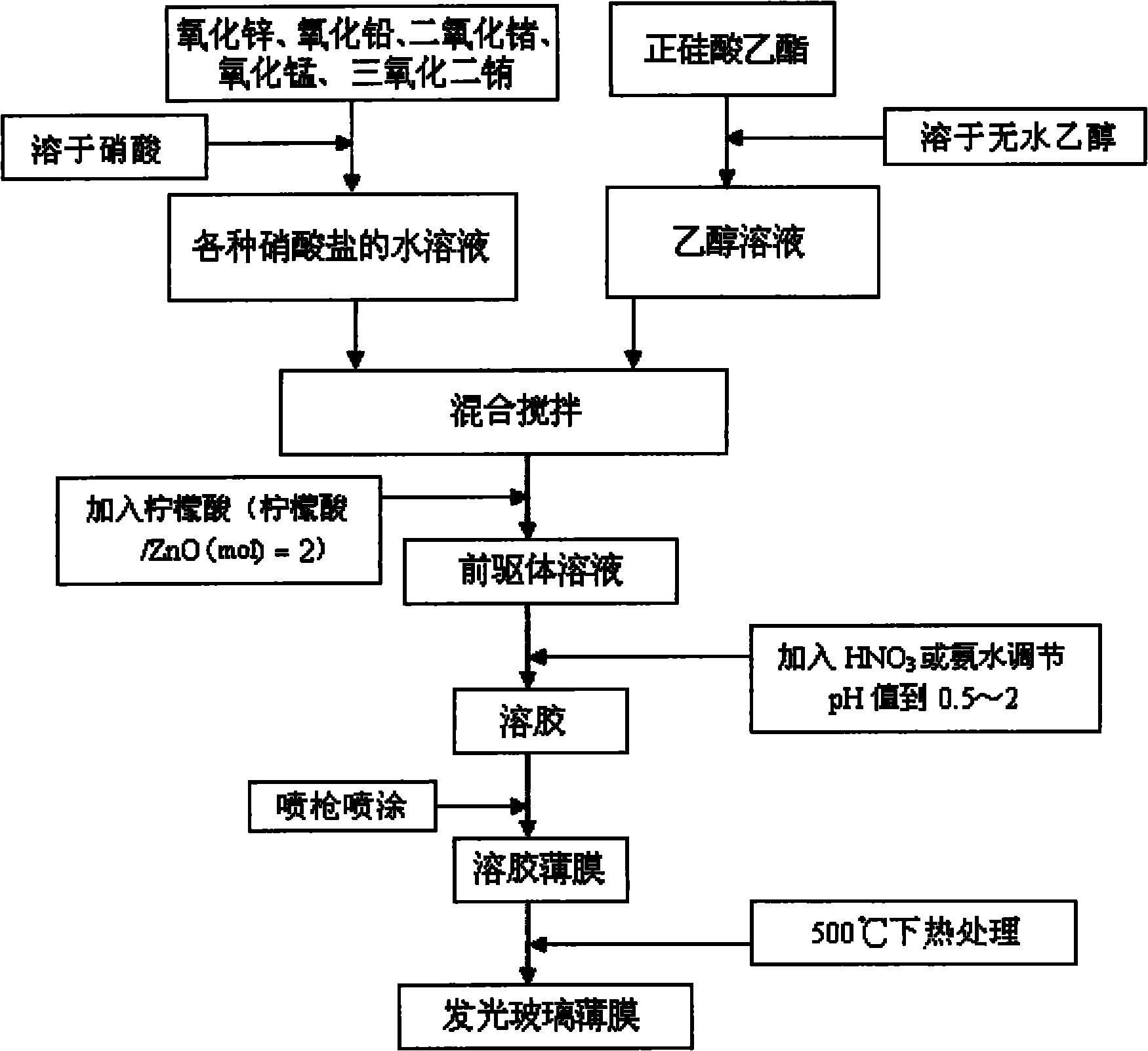Germanate glass luminescent film and preparation method
A germanate and thin film technology, which is applied in the field of germanate luminescent glass thin film and its preparation, can solve the problems of unfavorable production of high-performance luminescent materials, poor composition uniformity, and no requirement for material form.
- Summary
- Abstract
- Description
- Claims
- Application Information
AI Technical Summary
Problems solved by technology
Method used
Image
Examples
example 1
[0012] The molar percentage composition of the glass film is: 30% of zinc oxide; 20% of lead oxide; 40% of germanium dioxide; 4.9% of silicon oxide, 0.1% of manganese oxide and 5% of europium trioxide. Dissolve zinc oxide, lead oxide, germanium dioxide, manganese oxide, and europium trioxide in nitric acid to make a 0.5mol / L nitrate solution, and dissolve ethyl orthosilicate in anhydrous Ethanol, the Geli solution is mixed according to the proportion, and a certain amount of citric acid (according to citric acid: metal ion = 2: 1) is added as a chelating agent. Mix the prepared mixed solution with a magnetic stirrer, adjust the pH value to 1, make a sol and pour it into an atomizing container for use. Quartz glass is used as the substrate in the preparation. After being kept in a heating furnace at 500°C for 1 hour, the sol is pressurized by a pressure pump and enters the spray gun. After being atomized by high-pressure gas at the nozzle of the spray gun, it deposits on the hi...
example 2
[0014] The molar percentage composition of the glass film is: 25% of zinc oxide; 20% of lead oxide; 40% of germanium dioxide; 9.9% of silicon oxide, 0.1% of manganese oxide and 5% of europium trioxide. Dissolve zinc oxide, lead oxide, germanium dioxide, manganese oxide, and europium trioxide in nitric acid to make a 1mol / L nitrate solution, and dissolve ethyl orthosilicate in absolute ethanol at a volume ratio of 1:1 , mix the various solutions according to the proportion, and add a certain amount of citric acid (according to citric acid: metal ion = 2: 1) as a chelating agent. Mix the prepared mixed solution with a magnetic stirrer, adjust the pH value to 1, make a sol and pour it into an atomizing container for use. Quartz glass is used as the substrate in the preparation. After being kept in a heating furnace at 500°C for 1 hour, the sol is pressurized by a pressure pump and enters the spray gun. After being atomized by high-pressure gas at the nozzle of the spray gun, it d...
example 3
[0016] The molar percentage composition of the glass film is: 40% of zinc oxide; 10% of lead oxide; 40% of germanium dioxide; 14.9% of silicon oxide, 0.1% of manganese oxide and 5% of europium trioxide. Dissolve zinc oxide, lead oxide, germanium dioxide, manganese oxide, and europium trioxide in nitric acid to make a 0.5mol / L nitric acid solution, and dissolve ethyl orthosilicate in absolute ethanol at a volume ratio of 1:1 , mix the various solutions according to the proportion, and add a certain amount of citric acid (according to citric acid: metal ion = 2: 1) as a chelating agent. Mix the prepared mixed solution with a magnetic stirrer, adjust the pH value to 1, make a sol and pour it into an atomizing container for use. Quartz glass is used as the substrate in the preparation. After being kept in a heating furnace at 500°C for 1 hour, the sol is pressurized by a pressure pump and enters the spray gun. After being atomized by high-pressure gas at the nozzle of the spray gu...
PUM
 Login to View More
Login to View More Abstract
Description
Claims
Application Information
 Login to View More
Login to View More - R&D Engineer
- R&D Manager
- IP Professional
- Industry Leading Data Capabilities
- Powerful AI technology
- Patent DNA Extraction
Browse by: Latest US Patents, China's latest patents, Technical Efficacy Thesaurus, Application Domain, Technology Topic, Popular Technical Reports.
© 2024 PatSnap. All rights reserved.Legal|Privacy policy|Modern Slavery Act Transparency Statement|Sitemap|About US| Contact US: help@patsnap.com








